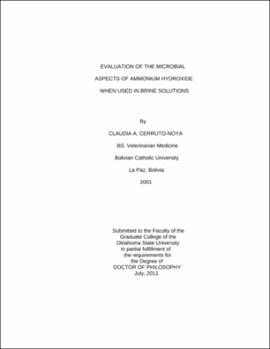| dc.contributor.advisor | DeWitt, Christina Mireles | |
| dc.contributor.author | Cerruto-Noya, Claudia A. | |
| dc.date.accessioned | 2013-11-26T08:22:33Z | |
| dc.date.available | 2013-11-26T08:22:33Z | |
| dc.date.issued | 2011-07 | |
| dc.identifier.uri | https://hdl.handle.net/11244/6592 | |
| dc.description.abstract | Scope and Method of Study: Ammonium hydroxide (AH) is considered a safe and suitable ingredient as a pH agent in brines for meat products up to final brine pH 11.6. However, its impact on microbial aspects of meats injected with a brine containing AH was not fully addressed previously. Four studies were conducted to determine whether AH possesses an antimicrobial effect when injected into meats. First, striploins were injected with 1% AH-brine or a phosphate-based-brine, and then MAP-packaged to evaluate APCs, Gram(-), LAB, and coliform counts. Subsequent studies focused on the pathogen Escherichia coli O157:H7. A multi-nozzle spray system was used to spray water, 1%, 2%, and 3% AH solutions onto inoculated meat-disk-samples with E. coli O157:H7. Next, striploins were pre-cored and inoculated with E. coli O157:H7 before they were injected with 1% AH-brine and then stored aerobically. The final study evaluated E. coli O157:H7 reductions over time. | |
| dc.description.abstract | Findings and Conclusions: AH-steaks had lower psychrotrophic, mesophilic, and Gramnegative counts than control (phosphate-steaks). All 1%, 2%, and 3% AH-solutions were effective in reducing E. coli O157:H7 compared to the control (water) and its effectiveness increased with time. When 1% AH-brine was injected into inoculated striploins with E. coli O157:H7, no-differences were found between AH-brine and control (no-AH brine) on days 0 and 1. The long term effect showed that the 1%-AH-surface samples had lower counts of E. coli O157:H7 than controls only when initial meat pH was < 5.7. These data suggests that 1%-AH-brine, when applied thorough needle injection, did not promote nor enhance the growth of E. coli O157:H7 under the conditions of these studies. The use of 1%-AH-brine may have several advantages for the industry such as: production of a clearer label, reduction of up to 50% of the sodium content in the brine, production of a phosphate-free brine, and an antibacterial effect against E. coli O157:H7. It is also important to point out the observation that AH has same effect on E. coli O157:H7 populations regardless the initial pH and this is an additional advantage because initial meat pH is highly variable. | |
| dc.format | application/pdf | |
| dc.language | en_US | |
| dc.rights | Copyright is held by the author who has granted the Oklahoma State University Library the non-exclusive right to share this material in its institutional repository. Contact Digital Library Services at lib-dls@okstate.edu or 405-744-9161 for the permission policy on the use, reproduction or distribution of this material. | |
| dc.title | Evaluation of the microbial aspects of ammonium hydroxide when used in brine solutions | |
| dc.contributor.committeeMember | Fathepure, Babu | |
| dc.contributor.committeeMember | McGlynn, William | |
| dc.contributor.committeeMember | Muriana, Peter | |
| dc.contributor.committeeMember | Morgan, Brad | |
| osu.filename | CerrutoNoya_okstate_0664D_11485.pdf | |
| osu.accesstype | Open Access | |
| dc.type.genre | Dissertation | |
| dc.type.material | Text | |
| dc.subject.keywords | ammonium hydroxide | |
| dc.subject.keywords | brine injection | |
| dc.subject.keywords | e. coli o157:h7 | |
| dc.subject.keywords | meat | |
| dc.subject.keywords | microbial | |
| thesis.degree.discipline | Food Science | |
| thesis.degree.grantor | Oklahoma State University | |
